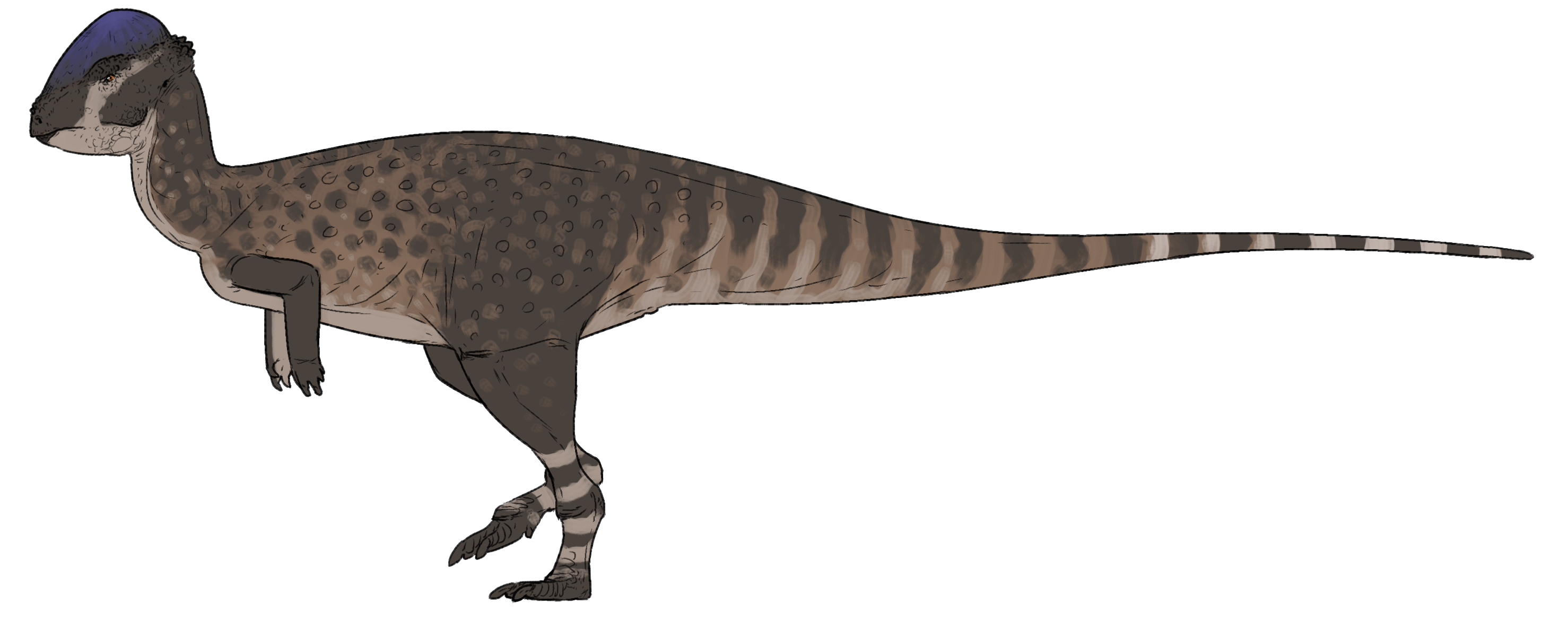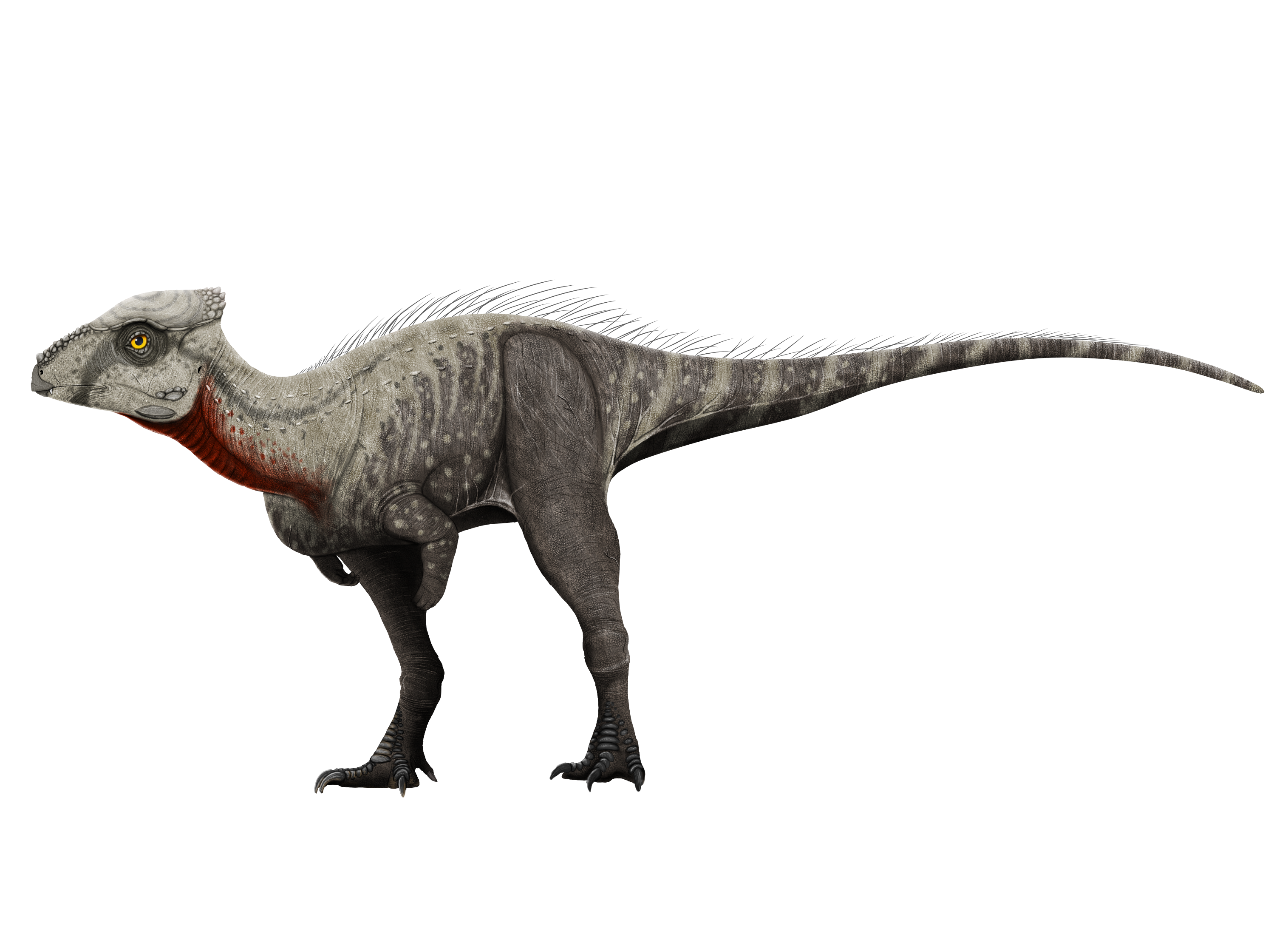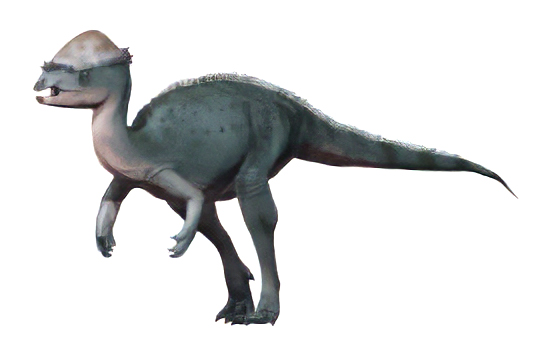|
Platytholus Clemensi
''Platytholus'' is an extinct genus of pachycephalosaurid dinosaur from the Late Cretaceous (Maastrichtian) Hell Creek Formation of the United States. The genus contains a single species, ''P. clemensi'', known from a partial skull. Discovery and naming The ''Platytholus'' holotype specimen, MOR 2915, was discovered during the early 2000s in sediments of the Hell Creek Formation, dated to the latest Maastrichtian age of the late Cretaceous period, in Garfield County, Montana. The specimen consists of a partial skull. In 2023, Horner, Goodwin & Evans described ''Platytholus clemensi'', a new genus and species of pachycephalosaurid, based on these fossil remains. The generic name, "''Platytholus''", combines the Latinised Greek "platys", meaning "flattened", "wide", or "broad", and "tholos", meaning a "small domed hill". The specific name, "''clemensi''", honors American paleontologist William A. Clemens Jr. Classification Horner, Goodwin & Evans (2023) recovered ''Platy ... [...More Info...] [...Related Items...] OR: [Wikipedia] [Google] [Baidu] |
Late Cretaceous
The Late Cretaceous (100.5–66 Ma) is the more recent of two epochs into which the Cretaceous Period is divided in the geologic time scale. Rock strata from this epoch form the Upper Cretaceous Series. The Cretaceous is named after ''creta'', the Latin word for the white limestone known as chalk. The chalk of northern France and the white cliffs of south-eastern England date from the Cretaceous Period. Climate During the Late Cretaceous, the climate was warmer than present, although throughout the period a cooling trend is evident. The tropics became restricted to equatorial regions and northern latitudes experienced markedly more seasonal climatic conditions. Geography Due to plate tectonics, the Americas were gradually moving westward, causing the Atlantic Ocean to expand. The Western Interior Seaway divided North America into eastern and western halves; Appalachia and Laramidia. India maintained a northward course towards Asia. In the Southern Hemisphere, Aus ... [...More Info...] [...Related Items...] OR: [Wikipedia] [Google] [Baidu] |
Latin
Latin ( or ) is a classical language belonging to the Italic languages, Italic branch of the Indo-European languages. Latin was originally spoken by the Latins (Italic tribe), Latins in Latium (now known as Lazio), the lower Tiber area around Rome, Italy. Through the expansion of the Roman Republic, it became the dominant language in the Italian Peninsula and subsequently throughout the Roman Empire. It has greatly influenced many languages, Latin influence in English, including English, having contributed List of Latin words with English derivatives, many words to the English lexicon, particularly after the Christianity in Anglo-Saxon England, Christianization of the Anglo-Saxons and the Norman Conquest. Latin Root (linguistics), roots appear frequently in the technical vocabulary used by fields such as theology, List of Latin and Greek words commonly used in systematic names, the sciences, List of medical roots, suffixes and prefixes, medicine, and List of Latin legal terms ... [...More Info...] [...Related Items...] OR: [Wikipedia] [Google] [Baidu] |
Hanssuesia Sternbergi
''Hanssuesia'' is a genus of pachycephalosaurid dinosaurs from the late Cretaceous period. It lived in what is now Alberta and Montana, and contains the single species ''Hanssuesia sternbergi''. ''Hanssuesia'' is based on a skull dome originally named ''Troodon sternbergi'' by Barnum Brown and Erich Maren Schlaikjer in 1943. The specific name honoured Charles Mortram Sternberg who found the dome in 1928 near Steveville in south Alberta. In 1945, it was transferred to ''Stegoceras'' by C.M. Sternberg himself, as a ''Stegoceras sternbergi''. The genus ''Hanssuesia'' was first named by Robert M. Sullivan in 2003. The generic name honours paleontologist Hans-Dieter Sues. The spelling variant "Hanssuessia" appeared in the publication, but the same year Sullivan chose for ''Hanssuesia'' as the valid name. Its type species is ''Troodon sternbergi'', and the ''combinatio nova'' is ''Hanssuesia sternbergi''. ''H. sternbergi'' is known from the holotype NMC 8817 and six referred specimen ... [...More Info...] [...Related Items...] OR: [Wikipedia] [Google] [Baidu] |
Hanssuesia
''Hanssuesia'' is a genus of pachycephalosaurid dinosaurs from the late Cretaceous period. It lived in what is now Alberta and Montana, and contains the single species ''Hanssuesia sternbergi''. ''Hanssuesia'' is based on a skull dome originally named ''Troodon sternbergi'' by Barnum Brown and Erich Maren Schlaikjer in 1943. The specific name honoured Charles Mortram Sternberg who found the dome in 1928 near Steveville in south Alberta. In 1945, it was transferred to ''Stegoceras'' by C.M. Sternberg himself, as a ''Stegoceras sternbergi''. The genus ''Hanssuesia'' was first named by Robert M. Sullivan in 2003. The generic name honours paleontologist Hans-Dieter Sues. The spelling variant "Hanssuessia" appeared in the publication, but the same year Sullivan chose for ''Hanssuesia'' as the valid name. Its type species is ''Troodon sternbergi'', and the ''combinatio nova'' is ''Hanssuesia sternbergi''. ''H. sternbergi'' is known from the holotype NMC 8817 and six referred specime ... [...More Info...] [...Related Items...] OR: [Wikipedia] [Google] [Baidu] |
Wannanosaurus For Wiki Review
''Wannanosaurus'' (meaning " Wannan lizard", named after the location where it was discovered) is a genus of basal pachycephalosaurian dinosaur from the Maastrichtian Upper Cretaceous Xiaoyan Formation, about 70 million years ago in what is now Anhui, China. The type species ''Wannanosaurus yansiensis'' was described by Hou Lian-Hai in 1977. It is known from a single partial skeleton, including a partial skull roof and lower jaw, a femur and tibia, part of a rib, and other fragments. Because it has a flat skull roof with large openings, it has been considered primitive among pachycephalosaurs. Sometimes it has been classified as a member of the now-deprecated family Homalocephalidae, now thought to be an unnatural assembly of pachycephalosaurians without domed skulls. Although its remains are from a very small individual, with a femur length of ~8 centimeters (3.1 in) and an estimated overall length of about 60 cm (2 ft),Holtz, Thomas R. Jr. (2011) ''Di ... [...More Info...] [...Related Items...] OR: [Wikipedia] [Google] [Baidu] |
Wannanosaurus
''Wannanosaurus'' (meaning " Wannan lizard", named after the location where it was discovered) is a genus of basal pachycephalosaurian dinosaur from the Maastrichtian Upper Cretaceous Xiaoyan Formation, about 70 million years ago in what is now Anhui, China. The type species ''Wannanosaurus yansiensis'' was described by Hou Lian-Hai in 1977. It is known from a single partial skeleton, including a partial skull roof and lower jaw, a femur and tibia, part of a rib, and other fragments. Because it has a flat skull roof with large openings, it has been considered primitive among pachycephalosaurs. Sometimes it has been classified as a member of the now-deprecated family Homalocephalidae, now thought to be an unnatural assembly of pachycephalosaurians without domed skulls. Although its remains are from a very small individual, with a femur length of ~8 centimeters (3.1 in) and an estimated overall length of about 60 cm (2 ft),Holtz, Thomas R. Jr. (2011) ''D ... [...More Info...] [...Related Items...] OR: [Wikipedia] [Google] [Baidu] |
Cladogram
A cladogram (from Greek language, Greek ''clados'' "branch" and ''gramma'' "character") is a diagram used in cladistics to show relations among organisms. A cladogram is not, however, an Phylogenetic tree, evolutionary tree because it does not show how ancestors are related to descendants, nor does it show how much they have changed, so many differing evolutionary trees can be consistent with the same cladogram. A cladogram uses lines that branch off in different directions ending at a clade, a group of organisms with a last common ancestor. There are many shapes of cladograms but they all have lines that branch off from other lines. The lines can be traced back to where they branch off. These branching off points represent a hypothetical ancestor (not an actual entity) which can be inferred to exhibit the traits shared among the terminal taxa above it. This hypothetical ancestor might then provide clues about the order of evolution of various features, adaptation, and other e ... [...More Info...] [...Related Items...] OR: [Wikipedia] [Google] [Baidu] |
Phylogenetic Analyses
In biology, phylogenetics () is the study of the evolutionary history of life using observable characteristics of organisms (or genes), which is known as Computational phylogenetics, phylogenetic inference. It infers the relationship among organisms based on empirical data and observed heritable traits of DNA sequences, protein amino acid sequences, and Morphology (biology), morphology. The results are a phylogenetic tree—a diagram depicting the hypothesis, hypothetical relationships among the organisms, reflecting their inferred evolutionary history. The tips of a phylogenetic tree represent the observed entities, which can be living Taxon, taxa or fossils. A phylogenetic diagram can be rooted or unrooted. A rooted tree diagram indicates the hypothetical common ancestor of the taxa represented on the tree. An unrooted tree diagram (a network) makes no assumption about directionality of character state transformation, and does not show the origin or "root" of the taxa in questi ... [...More Info...] [...Related Items...] OR: [Wikipedia] [Google] [Baidu] |
Acrotholus
''Acrotholus'' (Greek for "highest dome"- akros meaning highest and tholos meaning dome) is an extinct genus of pachycephalosaur dinosaur that lived during the Santonian of the late Cretaceous, in the Milk River Formation of Canada. The type species, ''A. audeti'', was named after Roy Audet allowing access to his ranch leading to the discovery of the species. The discovery of this specimen lead to several new revelations in the fossil records questioning the preservation of small-bodied organisms along with the evolution of early pachycephalosaurs. The iconic cranial dome found on ''Acrotholus'' makes it one of the earliest indisputable known members of the pachycephalosaur family. Like others of its clade, ''Acrotholus'' was a bipedal herbivore characterized by a dome-shaped head. The dome had often been associated with intra-species combat though exact method of contact have been debated. History of discovery The holotype was found in the Deadhorse Coulee Member of the Milk ... [...More Info...] [...Related Items...] OR: [Wikipedia] [Google] [Baidu] |
Prenocephale
''Prenocephale'' (meaning "sloping head") is a genus of small pachycephalosaurid dinosaur from the Late Cretaceous Nemegt Formation of Mongolia. It was similar in many ways to its close relative, ''Homalocephale''. Discovery The holotype specimen, Z. Pal. No. MgD-I/104, consists of an isolated yet well-preserved skull, dorsal vertebrae and ribs, sacrum, femora, and caudal vertebrae. It was discovered by the Polish-Mongolian Paleontological Expedition and was found at the Nemegt locality, in a sandstone layer of the Nemegt Formation. Additional specimens have been recovered from the Bügiin Tsav, Guriliin Tsav, and Tsaagan Khushuu localities of the formation. Description Adult ''Prenocephale'' measured in length and in body mass. Unlike the flattened wedge-shaped skull of ''Homalocephale'' (a possible juvenile trait also potentially seen in early growth stages of ''Pachycephalosaurus''), the head of ''Prenocephale'' was rounded and sloping. The dome had a row of small bony spik ... [...More Info...] [...Related Items...] OR: [Wikipedia] [Google] [Baidu] |
Sister Taxon
In phylogenetics, a sister group or sister taxon, also called an adelphotaxon, comprises the closest relative(s) of another given unit in an evolutionary tree. Definition The expression is most easily illustrated by a cladogram: Taxon A and taxon B are sister groups to each other. Taxa A and B, together with any other extant or extinct descendants of their most recent common ancestor (MRCA), form a monophyletic group, the clade AB. Clade AB and taxon C are also sister groups. Taxa A, B, and C, together with all other descendants of their MRCA form the clade ABC. The whole clade ABC is itself a subtree of a larger tree which offers yet more sister group relationships, both among the leaves and among larger, more deeply rooted clades. The tree structure shown connects through its root to the rest of the universal tree of life. In cladistic standards, taxa A, B, and C may represent specimens, species, genera, or any other taxonomic units. If A and B are at the same taxonomic ... [...More Info...] [...Related Items...] OR: [Wikipedia] [Google] [Baidu] |
Pachycephalosauridae
Pachycephalosauria (; from Greek παχυκεφαλόσαυρος for 'thick headed lizards') is a clade of ornithischian dinosaurs. Along with Ceratopsia, it makes up the clade Marginocephalia. With the exception of two species, most pachycephalosaurs lived during the Late Cretaceous Period, dating between about 85.8 and 66 million years ago. They are exclusive to the Northern Hemisphere, all of them being found in North America and Asia. They were all bipedal, herbivorous/omnivorous animals with thick skulls. Skulls can be domed, flat, or wedge-shaped depending on the species, and are all heavily ossified. The domes were often surrounded by nodes and/or spikes. Partial skeletons have been found of several pachycephalosaur species, but to date no complete skeletons have been discovered. Often isolated skull fragments are the only bones that are found. Candidates for the earliest-known pachycephalosaur include ''Ferganocephale adenticulatum'' from Middle Jurassic Period strata ... [...More Info...] [...Related Items...] OR: [Wikipedia] [Google] [Baidu] |







